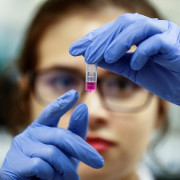8 positive impacts to look forward to post the covid-19 pandemic
Содержание:
- Call up Guinness World Records
- Understanding why COVID-positive people may travel
- Education becomes digitized & affordable
- Remote Working Turning Mainstream
- References
- Helps you Build Genuine Relationships
- Affordable Real Estate in Tier 1 Cities
- Blue-chip Stocks Becoming the Safe Bet to Invest
- Background
- Limitations of Serologic Tests
- Summary
- It’s a sensitive issue
- Reassessing priorities
- Not fit for purpose?
Call up Guinness World Records
One of the 10 fatal flaws in the original Corman-Drosten paper was that it was unclear whether it had ever been subjected to proper peer review – before, that is, the panel of experts took it upon themselves to do so. The paper had been submitted on January 22 and published the very next day. Peer review, when it takes place, is normally a long, drawn out process with plenty of back-and-forth, even when it is being rushed as much as possible. That it could be done in a single day beggars belief.
But that is what the authors are asking us to believe, as they are still claiming that their article was «peer-reviewed by two experts on whose recommendation the decision to publish was made.’’ Eurosurveillance may want to consider submitting this feat to Guinness World Records as the fastest peer review of all time – it may not be too late to get into the 2021 edition.
Also on rt.com
Landmark legal ruling finds that Covid tests are not fit for purpose. So what do the MSM do? They ignore it
Understanding why COVID-positive people may travel
Neda Gould, PhD, a clinical psychologist and assistant professor of psychiatry and behavioral sciences at Johns Hopkins Medicine, tells Yahoo Life that the behavior is “problematic” since “the consequences can be so dire for others.”
Dr. Iahn Gonsenhauser, chief quality and patient safety officer at The Ohio State University Wexner Medical Center, calls the behavior “truly reckless.” He tells Yahoo Life: “They know their diagnosis and they know the risk they pose and they’re choosing the behavior anyway. That’s very difficult to explain.”
Story continues
However, Gonsenhauser says it’s possible that people who are knowingly infected and travel anyway may be “making assumptions or rationalizations that are incorrect or misleading, which they ultimately think is OK.” Gonsenhauser notes that there has been “so much misinformation” surrounding the coronavirus, including some politicians who have downplayed the seriousness of the virus, despite the fact that more than 320,000 people have died from COVID-19 in the U.S. alone. Gonsenhauser says it’s possible that misleading information “led them to the conclusion that they’re not putting people around them at risk.”
Dr. Asim Shah, professor and executive vice chair of psychiatry and behavioral sciences at Baylor College of Medicine, tells Yahoo Life that it may be selfishness or denial that causes people in these circumstances to travel and put others at risk.
“But more than that, what we are seeing is in our country, unfortunately, people tend to push back against authority,” Shah says. During the pandemic, that can mean people refusing to wear masks or gathering with groups of people outside of their household. “They tend to use the wording of ‘rights’ or ‘civil rights,”’ Shah says. “While all that is true — that is your right,” he says that people don’t have “the right to hurt somebody else.”
Shah continues: “If you’re the only one who will be affected, maybe that’s OK. But people tend to forget by not wearing a mask and traveling while positive, you’re hurting others,” which is “infringing on someone else’s rights.” Shah adds: “The sad part is people are not realizing they are risking others.”
Gonsenhauser notes that in the U.S., independence is a value Americans “cherish.” But he says that we can still be a nation that makes a collective effort to stay safe during the pandemic without losing our independence. In the past, “when we’ve been engaged in large-scale national conflicts, there is that coming together,” Gonsenhauser says, “and instead of that happening, this was used as an opportunity to drive us apart and make enemies of each other and that’s so unfortunate. It’s interesting that so many people who stand on a platform of patriotism are choosing to not bear the responsibility that their nation is asking of them.”
Another explanation is that, given we’re almost a year into the coronavirus pandemic, Gonsenhauser says that COVID fatigue is a “very real affliction” that may also be a factor. “People are struggling, and they’re feeling isolated and worn down,” he says.
However, Gonsenhauser adds that for anyone who has recently tested positive, “it’s extremely important you observe quarantine isolation,” saying, “You do put those around you at very high risk when you’re traveling.”
But Gould notes that the cases of COVID-positive people traveling seem to be “few and far between” and that the “good news is that the message has gotten through to most people since we’re not seeing these instances a lot.” In the case of the couple who were arrested and charged, Gould says that the arrests will likely further “get the message across,” adding: “It’s unfortunate it has to go to that extreme. If that’s not a warning, then I don’t know anything that would be.”
Read more from Yahoo Life:
Want lifestyle and wellness news delivered to your inbox? Sign up here for Yahoo Life’s newsletter.
Education becomes digitized & affordable
The pandemic had posed a threat to the whole education system. Schools, universities, and colleges have been shut down. Yes, it is saddening but have you looked at the brighter side yet? Educational Institutions have found a way to overcome this immensely challenging series of events. Classes have begun again, thanks to technology.
Online classes have become the new norm for educational institutions and it has come with a few benefits too. Institutions can now save on the infrastructural costs and as a result, the students needn’t bear the brunt of the costs, making it more affordable. Moreover, parents will get first-hand knowledge about how classes are taught and can directly understand how their child perceives concepts. As the online education system grows, we can expect an increase in the reach and accessibility of education within every section of the society.
Every coin has two faces. With bad comes the good, and these are some of the predictions that I think would stick and become the norm. Countries everywhere are still fighting this pandemic, and we sure are going to overcome this.
We’re a race of survivors, and we’re going to win this too. I agree the battle is hard & long. But let’s look forward and focus on the brighter side for all we have through these difficult times are these & nothing else.
I would love to hear your take on this and please share the trends that you think are going to emerge to welcome this new world?
Stay physically distant but socially connected. Please take care & be safe.
Vipin Thomas
Director of Revenue Operations at SurveySparrow
A versatilist Customer Success professional zealous about driving predictable B2B SaaS Growth, Retention and Advocacy.
Remote Working Turning Mainstream
From Zapier to Aha to Invision, many companies, now, work remotely, with 100% of the workforce functioning virtually- with little to zero physical offices at all. Even we, at SurveySparrow, has undergone the transition and built a remote team. With cities locked down, organizations across the globe had to make this obligatory shift towards this realm of working remotely.
A partially remote environment sometimes hinders you from reaping all the benefits of remote working. The quarantines have made all businesses go 100% remote. This has also helped the teams to trust each other. Companies are getting into the culture where they trust the integrity of their employees & that they will loyally work even when there’s no one to look over their shoulders every now and then. Well, then, the future of work after COVID-19 definitely looks good!
References
-
Grady D. The pandemic’s hidden victims: sick or dying, but not from the virus. New York Times. 20 April 2020. www.nytimes.com/2020/04/20/health/treatment-delays-coronavirus.html.
-
- Chang A,
- Schnall AH,
- Law R,
- et al
. Cleaning and disinfectant chemical exposures and temporal associations with covid-19: National Poison Data System, United States, January 1 2020-March 31 2020. MMWR Morb Mortal Wkly Rep2020;69:496-8.doi:10.15585/mmwr.mm6916e1 pmid:32324720
OpenUrlCrossRefPubMed
-
Bharath D. Suicide, help hotline calls soar in Southern California over coronavirus anxieties. Orange County Register. 19 April 2020. www.ocregister.com/2020/04/19/suicide-help-hotline-calls-soar-in-southern-california-over-coronavirus-anxieties.
-
Dazio S, Briceno F, Tarm M. Crime drops around the world as covid-19 keeps people inside. Associated Press. 11 April 2020. https://apnews.com/bbb7adc88d3fa067c5c1b5c72a1a8aa6.
-
NASA. Airborne nitrogen dioxide plummets over China. 2 March 2020. www.earthobservatory.nasa.gov/images/146362/airborne-nitrogen-dioxide-plummets-over-china.
-
Burke M. Covid-19 reduces economic activity, which reduces pollution, which saves lives. G-FEED.org. 8 March 2020. www.g-feed.com/2020/03/covid-19-reduces-economic-activity.html.
-
Shilling F, Waetjen D. Special report (update): impact of covid-19 mitigation on numbers and costs of California traffic crashes. 15 April 2020. https://roadecology.ucdavis.edu/files/content/projects/COVID_CHIPs_Impacts_updated_415.pdf.
Helps you Build Genuine Relationships
We all have been so busy living the ‘life,’ many of us have lost those real, genuine moments we have with our loved ones. It could have been the busy schedules, running around to make ends meet, & rushing to be in urgent meetings.
Sure, maybe you were lucky enough to go for family vacations every now & then. But even then, didn’t you dread those pending files waiting at your workstation?
Now, the COVID-19 situation has positively impacted the way you emote and maintain relationships. You get to spend your time with your family and plan your work better. This actually helps you build a better future for both your work and family.
As life slowed down, we have found ways to stay connected with people, even if it’s virtually. Reconnect with your loved ones and retrospect.
Affordable Real Estate in Tier 1 Cities
Running businesses remotely is no longer something that we think is impossible & can also bring about this massive wave of change in Real estate, especially in the tier 1 cities. With businesses realizing they no longer need a fancy, large physical space in the city center to run their business as smoothly as ever, the demand for ‘hot’ places is going to come down.
The ones who do need physical spaces are going to stick with smaller spaces and it wouldn’t matter where they reside. Distances are no longer a challenge; companies get to hire talents beyond zip codes as long as there are enough resources.
When the need for physical buildings drops, naturally, the demand for it does as well, which dips the prices. Thus, it becomes affordable to all.
Blue-chip Stocks Becoming the Safe Bet to Invest
Investing in blue-chip stocks does have a reputation for being plain boring, stodgy, and is sometimes considered a little outdated. It isn’t an accident that they are overwhelmingly popular amidst the wealthy investors and almost every rock-solid financial institution.
The current trend suggests that the blue-chip stocks have minted money in store for owners who are prudent enough to hang on to them with tenacity through thick & thin. Economists predict that you might be able to double your money in just two years. The reason blue chips stocks are considered relatively safe is that the dividend-paying stocks tend to fall less in bear markets.
The economic impact of COVID-19, as we know, is severe; like the blow of a sledgehammer. Even if the economy comes to a standstill, blue-chip stocks become somewhat a relatively safe harbor. Wise investments are one of the ways to ride the COVID-19 economic crisis, safely.
Background
Serologic assays for SARS-CoV-2, now broadly available, can play an important role in understanding the virus’s epidemiology in the general population and identifying groups at higher risk for infection. Unlike direct detection methods such as viral nucleic acid amplification or antigen detection tests that can detect acutely infected persons, antibody tests help determine whether the individual being tested was previously infected—even if that person never showed symptoms. Serologic tests detect resolving or past SARS-CoV-2 virus infection indirectly by measuring the person’s humoral immune response to the virus. Therefore, serologic assays do not typically replace direct detection methods as the primary tool for diagnosing an active SARS-CoV-2 infection, but they do have several important applications in monitoring and responding to the COVID-19 pandemic.
Although serologic tests should not be used at this time to determine if an individual is immune, these tests can help determine the proportion of a population previously infected with SARS-CoV-2 and provide information about populations that may be immune and potentially protected. Thus, demographic and geographic patterns of serologic test results can help determine which communities may have experienced a higher infection rate and therefore may have a higher proportion of the population with some degree of immunity, at least temporarily. In some instances, serologic test results may assist with identifying persons potentially infected with SARS-CoV-2 and determining who may qualify to donate blood that can be used to manufacture convalescent plasmaexternal icon as a possible treatment for those who are seriously ill from COVID-19.
Limitations of Serologic Tests
At present, the immunologic correlates of immunity from SARS-CoV-2 infection are not well defined. Representatives from BARDA, CDC, FDA, NIH, the Office of the Assistant Secretary for Health (OASH), Department of Defense (DoD), and White House Office of Science and Technology Policy (OSTP) are working with members of academia and the medical community to determine whether positive serologic tests are indicative of protective immunity against SARS-CoV-2. This work includes assessing the level of antibodies required for protection from reinfection, the duration of that protection, and the factors associated with development of a protective antibody response. The kinetics of antibody response, longevity of antibodies, the ability of antibodies to protect from repeat infection, the protective titer of neutralizing antibody, and the correlation of binding antibody titers to neutralization ability are yet to be determined. Although animal challenge studies demonstrate protection in the short run, demonstration of long-term protection in humans will require future study. Hence, pending additional data, the presence of antibodies cannot be equated with an individual’s immunity from SARS-CoV-2 infection.
Some tests may exhibit cross-reactivity with other coronaviruses, such as those that cause the common cold. This could result in false-positive test results. Some persons may not develop detectable antibodies after coronavirus infection. In others, it is possible that antibody levels could wane over time to undetectable levels. IgM and IgG antibodies may take 1 to 3 weeks to develop after infection. Thus, serologic test results do not indicate with certainty the presence or absence of current or previous infection with SARS-CoV-2.
Summary
On This Page
Serologic methods have important public health and clinical uses for monitoring and responding to the COVID-19 pandemic.
- Several serologic assays for SARS-CoV-2 have Emergency Use Authorization (EUA) by the U.S. Food and Drug Administration (FDA), which has independently reviewed their performance.
- Currently, there is no identified advantage whether the assays test for IgG, IgM and IgG, or total antibody.
- It is important to minimize false-positive test results by choosing an assay with high specificity and by testing populations and individuals with an elevated likelihood of previous exposure to SARS-CoV-2. Alternatively, an orthogonal testing algorithm (i.e., employing two independent tests in sequence when the first test yields a positive result) can be used when the expected positive predictive value of a single test is low.
- Antibodies most commonly become detectable 1–3 weeks after symptom onset, at which time evidence suggests that infectiousness likely is greatly decreased and that some degree of immunity from future infection has developed. However, additional data are needed before modifying public health recommendations based on serologic test results, including decisions on discontinuing physical distancing and using personal protective equipment.
It’s a sensitive issue
So how could this have happened? The answer has to do with the sensitivity of PCR (Polymerase chain reaction) tests for Covid, which it turns out can be ramped up according to the taste of the testing companies. Most testing companies have chosen the outrageously high sensitivity limit of 40 PCR cycles – meaning that the DNA in a sample is exponentially increased 40 times in order to amplify its signal.
Read more
But using such a ridiculously sensitive test means that the faintest traces of a dead virus, or even leftovers from previous infections, can result in a positive. Professor Juliet Morrison, a University of California virologist, said that even a limit of 35 PCR cycles is too high, let alone 40. She said she was “shocked that people would think that 40 could represent a positive.” But apparently, pretty much everyone in the US Covid brain trust took exactly that on faith.
If a significant percentage of tests doesn’t tell us anything about the patient’s true Covid status, the real scale of the pandemic becomes impossible to estimate . For a seasoned ignorer of statistics that contain Covid ‘cases’, there are no surprises here. The truth is, there was never any reason to treat them as written in stone . The FDA, for instance, has only now been forced to concede that they have no idea how different testing companies determine which the positive and negative tests are: they just accept whatever data they are given.
But it should not have taken some journalist to ask the right question to discover this: a bit of common sense would have been enough. What is it going to take for these professional virologists to drop their assumptions and models, and just start acting based on the facts at hand?
Also on rt.com
We might have to wait forever for science to show the Covid threat is over, so let’s use our common sense & get back to normal
Reassessing priorities
If the pandemic has prompted risky behaviour for some, it has encouraged others to embrace preventive measures. Randy Mayer, chief of the Bureau of HIV, STD, and Hepatitis at the Iowa Department of Public Health, said the public has become more responsive to calls from the department’s partner services, which perform contact tracing for people who test positive for HIV, gonorrhoea, and syphilis. “People are really interested in calling us back and finding out what information we have for them,” he said. That increased cooperation, Mayer said, may be a benefit of people associating public health departments with trying to keep them safe from covid-19.
Even so, he worries that a noticeable reduction in the number of new HIV diagnoses may partially reflect a reduction in available testing with many clinics open for limited hours, if not completely closed. But growing evidence suggests that more people are also heeding recent pleas by public health officials and even dating apps to reduce the risk of covid-19 infection by avoiding casual sex with new partners. Researchers in Portugal and the UK told The BMJ that they were beginning to see shifts in the incidence of sexually transmitted infections but were still collecting data to support their observations.
Not fit for purpose?
It would be difficult to argue that the US Covid testing is fit for purpose in its current state. The experts seem to base every decision now on case numbers or derivatives thereof, despite the apparent lack of association between fluctuating case numbers and hospital admissions and deaths; the latter two of which have been relatively negligible for months – even when taking into account recent rises in parts of the world — compared to the springtime peaks. But they keep ringing that bell: ever more testing, they toot, will somehow lead us into their ‘new normal’.
It’s a virus so deadly, you need a test to tell whether you have it or not. So goes the refrain of many lockdown skeptics, Covidiots and anti-maskers, of whom I am an indignant supporter. Something has gone… not just wrong, but totally haywire… when the might of the world’s scientific establishment is trained with the zeal of a Witchfinder General on one particular microscopic particle. Not even one that’s most likely to kill you; the show it is the eighth most common cause of death in England, and it doesn’t make the top ten in Wales.
Meanwhile, in Wuhan, the original source of this disease, the pool parties are in full swing. They don’t seem to be too worried about PCR tests or contact tracing, or even the virus itself. The Chinese government says that their supreme lockdown was so awesome that they now have zero Covid: probably a biological impossibility. Maybe they just stopped testing, and decided to get on with their lives. A turn of events we are unlikely to see if the US or Europe any time soon, for better or worse.
Think your friends would be interested? Share this story!







